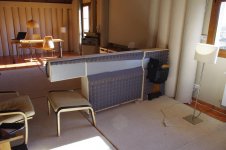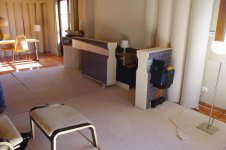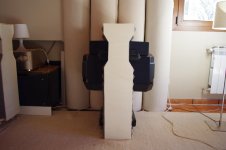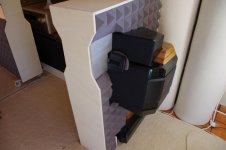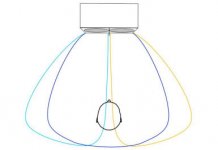I am no longer using electronic xtalk cancellation. Back to the good old barrier. This one on wheels and offering as good a size/performance ratio as I could come up with. I add some foam panels on top for music but not for movies ( it would block the screen and besides it is not really necessary).
Attachments
A more detailed view. The flat portion by the tweeter is styrofoam. It lets the higher frequencies reach the ear.Any really absorbing material (such as the pyramid foam used elsewhere in this barrier) was placed in the path from tweeter to ear the highs would be gone.
Attachments
I think it's much more common that people would (and probably already do) use headphones when sound quality is of concern. Something like the Smyth Realiser. That device can deliver perfect speaker crosstalk cancellation.
Digging back in the thread a ways, after doing some fairly enjoyable conventional headphone listening recently I revived my thoughts that headphones solve the x-talk problem perfectly, and so it seems to me that the "only" thing (or at least primary thing - you probably also want ambiance) left is to get the pinna correction correct in order to get 'ambio over headphones'. From all reports I can find, the Smyth Realiser mentioned earlier is flat out amazing and recreates the 'speakers in a room' effect extremely well. So, logically, it must be doing a fairly good job of automatically measuring the PRIR.
So, thought experiment time. If we use an in-ear mic like this : USB Microphone, Stereo Microphone, Preamplifier, Digital Recorder, Custom Cables and more at Rock Bottom Prices from The Sound Professionals - Great deals on Microphone, Preamplifier, Digital Recorder, Cable and more! , what would the process look like to try to get a set of impulse responses that would allow ambio over headphones?
- measure IR of mic in 'free field' to get a baseline for calibration (may not actually be needed, since mic response should divide out)
- measure IR of mic in-ear directly from the headphone output (repeat each side)
- measure IR of mic in-ear directly from the front (repeat each side)
Now, 'divide' (i.e. convolve with the inverse) the front response by the side headphone response to get the correction filter to apply to the signal to the headphones. Is it that simple?
You could probably somehow come up with a correction for the response of the headphones this way too by measuring them on a flat baffle rather than the ear, which might allow decomposing the correction into 2 parts so that the same pinna response could be used with multiple headphones.
I'm also not sure how using IEMs might change this - since it eliminates the pinna influence, doe is eliminate the need for a headphone measurement?
Seems too easy, and there is a lot of practical detail missing. Still, seems viable and given the surprisingly low price of the mic it might be worth a shot.
Crazy? Stupid?
I'm thinking we need a new sound system setup with a divider that sits on a coffee table right in front of us.
Norman
been done partially but disco'd
Emes The Owl Active HR System - Unique studio monitor design from EMES using the patented Embracing Sound Experience System™.
An externally hosted image should be here but it was not working when we last tested it.
It lets the higher frequencies reach the ear.
Direct sound at higher freq.s.. is that necessarily a good thing (depending on the freq.)?
phy-hp driver ambio setup


An externally hosted image should be here but it was not working when we last tested it.
I happenned to stand behind an electronically xt-canceled ambiopole once, and the naturalness of the sound struck my attention. No direct sound at higher frequencies yet the listening experience was very satisfying. After this, I followed the stereo sound from a single driverthread with interest.Direct sound at higher freq.s.. is that necessarily a good thing (depending on the freq.)?
Today 02:55 AM
However, direct sound from the tweeters is still giving me the best experience overall.
Back to the good old barrier.
It's nice to see such a passion of yours with effort !

Direct sound at higher freq.s.. is that necessarily a good thing (depending on the freq.)?
Scott you know that is heresy !
Still, the mystery of high freq direct sound.. Hmmm..
 There may be one exception: The physical barrier !
There may be one exception: The physical barrier ! I remember similar perception with the physical barrier as with my current single speaker stereo SSSx5. Lateral shift and head turning had no effect on sound, no collapse as in conventional stereo triangle. Just that with SSSx5 benefit is greater: I can move laterally about 1m and turn my head all the way 360deg. The sound still comes from 'there' (and not from the speaker).
- Elias
Scott you know that is heresy !
Still, the mystery of high freq direct sound.. Hmmm..There may be one exception: The physical barrier !

- Elias
From conventional design and placement.. yeah.
Still, when you look at head-shading vs. freq. vs. loudspeaker separation (in relation to the listener), 99% of designs/placement have to much channel separation (as perceived by an average listener) at higher freq.s..
This is perhaps counter-intuitive to an intended application like Ambiophonics, but it's still a problem.
For freq.s above 3.5 kHz I'm starting to think that *non* direct sound is preferable - where you can't "lock onto" the increasing pressure gradient of the tweeter. This suggests a physical barrier between tweeter and the listener. Still, doing that will lower the spl at those freq.s when compared to the average (for the listener) - so it's likely that the tweeter will need some added gain to compensate. Perhaps the loss in pressure is why poldus still finds that direct sound from the tweeters provides the best overall experience?
As for a barrier..
While it can provide for increased separation at higher freq.s (depending on absorption) - it's not going to do much for most of the midrange.
To me the barrier format is every bit as flawed (both conceptually and in practice) as the standard radiation pattern of most loudspeakers. (i.e. directive higher in freq. and non-directive at lower freq.s).
Last edited:
For freq.s above 3.5 kHz I'm starting to think that *non* direct sound is preferable
You too !
 It seems people, in a constant manner, one by one, convert from direct sound preference to non direct sound preference - expecially for signals at high freqs
It seems people, in a constant manner, one by one, convert from direct sound preference to non direct sound preference - expecially for signals at high freqs This suggests a physical barrier between tweeter and the listener.
Please don't remind me about it !
An externally hosted image should be here but it was not working when we last tested it.
To understand what was behind the 'barrier', a review of the thread
http://www.diyaudio.com/forums/multi-way/10962-stereolith-loudspeakers-question.html
is mandatory
While it can provide for increased separation at higher freq.s (depending on absorption) - it's not going to do much for most of the midrange.
It's true barrier loses its effectiveness with increasing wavelength. However it does work in the dominant freq range of spatial hearing, which is the key and the reason why it works at all. High freqs appears to overrule low freqs in directional perception. Even if contradicting cues of high and low freqs are present, high freqs win and determine the perceived image. This is my experience.
- Elias
I must say that some pieces have been locked in place after conducting all these experiments over the years.
Well, this is a thread about Ambiophonics so let me keep myself in topic
As I understand the two most characteristic features of Ambiophonics are:
1) Centrally in front located sound sources (speakers)
2) Cross talk cancelling
Everyone by now knows it sounds good so how do these two features help in it ?
so how do these two features help in it ?
1) For most of the available recordings the major portion of the sounds are mixed or recorded by a mic in the central front location. Then it makes sense to put a speakers there where most sound should be coming from and by doing so it creates least of spatial error.
2) By removing the cross talk there will be no comb filtering interference field in the listening position, which in conventional stereo triangle destroys the stereo illusion if head is moved or turned. Ambiophonics do not suffer from this to the same extent.
Now, my current favourite system SSSx5:
Elias Pekonen Home Page - Stereophonic Sound from a Single Speaker
have also two characteristic features:
1) Centrally located sound source (speaker).
2) No comb filtering interference field in the listening position.
In this case
1) is achieved by a single box with three elements and a linear (optimal) matrix. Mono sound comes from a single location, true mono that is. (stereo requires side wall reflections)
and
2) is achieved, not by cross talk cancelling, but 'decorrelation' at high freqs from the side wall reflections so no comb filtering at the listening position is formed. I can move around laterally up to 1m and turn my head 360deg in the listening position and the image do not collapse. The speaker is not localisable.
How do these concepts, SSSx5 and Ambiophonics, can have the same characteristic features ? They are so alike, and so different at the same time
They are so alike, and so different at the same time 
- Elias
Well, this is a thread about Ambiophonics so let me keep myself in topic

As I understand the two most characteristic features of Ambiophonics are:
1) Centrally in front located sound sources (speakers)
2) Cross talk cancelling
Everyone by now knows it sounds good
1) For most of the available recordings the major portion of the sounds are mixed or recorded by a mic in the central front location. Then it makes sense to put a speakers there where most sound should be coming from and by doing so it creates least of spatial error.
2) By removing the cross talk there will be no comb filtering interference field in the listening position, which in conventional stereo triangle destroys the stereo illusion if head is moved or turned. Ambiophonics do not suffer from this to the same extent.
Now, my current favourite system SSSx5:
Elias Pekonen Home Page - Stereophonic Sound from a Single Speaker
An externally hosted image should be here but it was not working when we last tested it.
have also two characteristic features:
1) Centrally located sound source (speaker).
2) No comb filtering interference field in the listening position.
In this case
1) is achieved by a single box with three elements and a linear (optimal) matrix. Mono sound comes from a single location, true mono that is. (stereo requires side wall reflections)
and
2) is achieved, not by cross talk cancelling, but 'decorrelation' at high freqs from the side wall reflections so no comb filtering at the listening position is formed. I can move around laterally up to 1m and turn my head 360deg in the listening position and the image do not collapse. The speaker is not localisable.
How do these concepts, SSSx5 and Ambiophonics, can have the same characteristic features ?
- Elias
Last edited:
You too !It seems people, in a constant manner, one by one, convert from direct sound preference to non direct sound preference - expecially for signals at high freqs
There must something behind it !
It's true barrier loses its effectiveness with increasing wavelength. However it does work in the dominant freq range of spatial hearing, which is the key and the reason why it works at all. High freqs appears to overrule low freqs in directional perception. Even if contradicting cues of high and low freqs are present, high freqs win and determine the perceived image. This is my experience.
- Elias
Yup.
Still, the sofa pillow is too large (though it should make the overall spl more uniform as a result). It's size is covering a MUCH lower bandwidth than strictly above 3.5 kHz.
I think perhaps a better method for above 3.5 kHz is a return to the acoustic lens.
The L/R barrier doesn't work effectively at low enough freq.s.. It should ideally work all the way down to DC, but even as a "compromise" should extend to 200 Hz or so. Most barriers are working no lower than the average head-shading range.
Last edited:
Well, decided to spring for the binaural mic in order to experiment. I still don't see anything wrong with the 'ambio over phones' idea, and it should be relatively easy to prototype. My big question is whether a completely dry presentation will be acceptable or whether some ambiance will be needed. If dry is ok, the system could probably run on the new Minidsp OpenDRC platform which would make for a convient package.
Not entirely sure when I'll get to this, but I'll report results when I have them.
Not entirely sure when I'll get to this, but I'll report results when I have them.
been done partially but disco'd
Emes The Owl Active HR System - Unique studio monitor design from EMES using the patented Embracing Sound Experience System™.
An externally hosted image should be here but it was not working when we last tested it.
EmbracingSound® Zero Boundaries
It should work, if sitting in the near field or not too far from the speaker. I suspect the lateral sweet spot might be tiny though as the principle is to generate two sharp lobes and the listener is to expected to sit between them.
Also there was a white paper with math and all linked about this technology in diyaudio forum, in one of these interesting treads of alternative stereo technologies
- Elias
Attachments
I am no longer using electronic xtalk cancellation. Back to the good old barrier.
Hi poldus,
Did you also try the barrier method with the speakers at ±30° like in a conventional stereo setup?
It only produces a small soundstage at frequencies that pinna localization is dominate. This is why I'm convinced that the speakers should be placed at +-15 degrees, an average of conventional and mono. If they are placed too close together, treble comes from the middle and all other frequencies come from the sides. If they are spread too far apart, there are no pinna cues from straight forward. ( I only set R.A.C.E. For a 90 degree spread. ) I think this is where R.A.C.E. is superior to a barrier, where as you can control the amount of spread.
Last edited:
Markus: yes, I did. But it did not sound good.Did you also try the barrier method with the speakers at ±30° like in a conventional stereo setup?
MeloTheory: Ambiop. sounds best to me with speakers as close together as phyisically possible. In my experience so far, a barrier succeeds in moving the highs to the sides, while electronic cancellation does not pull the trick convincingly enough.If they are placed too close together, treble comes from the middle and all other frequencies come from the sides.
Markus: yes, I did. But it did not sound good.
What was the difference?
- Home
- Loudspeakers
- Multi-Way
- Try Ambiophonics with your speakers
